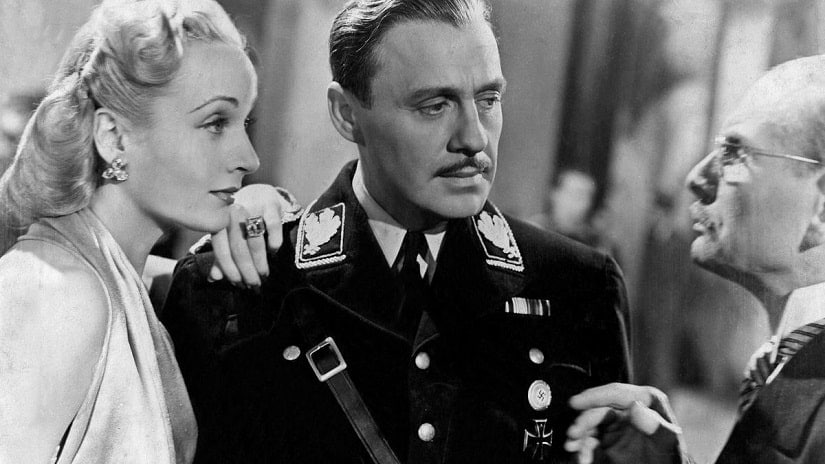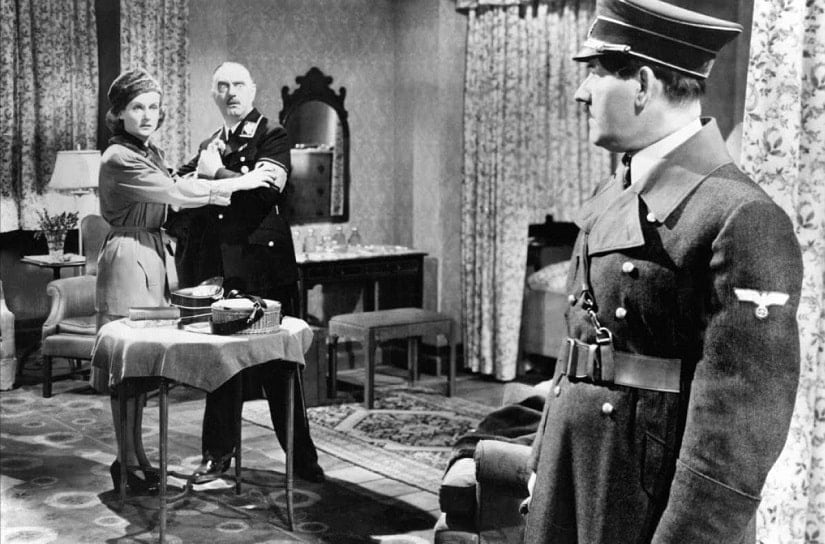‘At the Movies’ is a fortnightly column on Hollywood’s Golden Era (1920s-50s) revisiting films of historical, cultural and/or aesthetic significance. Read more from the series here . *** Ernst Lubitsch was a German immigrant to Hollywood who made some of the most memorable works of its Golden Era. His suave, sexy romantic comedies brought a touch of European elegance to Hollywood and helped found a genre that thrives till date. His sophisticated sense of screen comedy, characterised by subtle, effortless and precise exposition and seamless technique, has influenced comedic filmmakers ever since — not the least of all Billy Wilder, who was a screenwriter on two of his films. Lubitsch worked for almost all the major companies in Hollywood, but his finest achievement was a picture made outside of these studios: To Be or Not to Be (1942) was produced by Romaine, a house set up by Alexander Korda, and distributed by United Artists. Arguably the greatest Hollywood comedy of the sound era, To Be or Not to Be is a daring, intellectually provocative work that stands testament to the power of life-sustaining humour in face of unspeakable horror. Days before Hitler’s invasion of Poland in 1939, a Jewish troupe in Warsaw tries to put up a play about the Nazis. There’s a disagreement between the actors and the director on whether it should be a comedy or a serious, realistic drama — a split equally applicable to Lubitsch’s film, which bandies the viewer between two approaches to the subject matter. After the Nazis take over, the troupe is forced to shelve the play and continue performing Hamlet. The early stretch of the film centres on a comic romantic triangle involving the troupe’s lead actor, Joseph Tura (Jack Benny), his wife and actress Maria Tura (Carole Lombard, in her last screen role) and an admirer of Maria’s, the war pilot Sobinski (Robert Stack). Warsaw is soon bombed by the Luftwaffe and the film turns into a tense espionage drama. Sobinski flees to England, and becomes part of the Polish division of the Royal Air Force. The RAF division is infiltrated by Professor Siletsky (Stanley Ridges), a Nazi spy who gathers information about Polish underground resistance fighters. By the time Sobinski discovers this, the professor is already on his way to the Gestapo office in Warsaw. Sobinski sets out to Poland to stop the professor, but is forced to go underground in Warsaw after the Nazis spot him. He enlists the help of the theatre troupe to mislead the professor, take the documents from him and kill him if need be. This puts the film back on the comedic track, with ingenious scenes of disguise, deceit and subterfuge to follow. [caption id=“attachment_7748701” align=“alignnone” width=“825”]  Still from To Be or Not to Be, 1942[/caption] Jura first masquerades as the Gestapo commander to get the professor’s files, but he blows his own cover in a fit of jealousy over the professor’s comments about Maria. He then masquerades as the professor to meet the real Gestapo commander Col. Ehrhardt (Sig Ruman), who soon discovers that the real professor is dead. Their mission accomplished, the entire troupe orchestrates an escape plan in which they fly out of Poland in Hitler’s own plane. All through Lubitsch’s film is an osmosis between reality and artifice. In the film’s first scene, a street corner in Warsaw (itself recreated on a studio lot) is visited by Hitler, behind whom a shop window closes like theatrical curtain. A while later, it’s revealed that this Führer was simply one of the troupe’s actors in disguise. A Gestapo interrogation scene turns out to be a scene from a play, while the bombing of Warsaw is described as a “show” put up by the Nazis “without a censor to stop them”. As the play is interrupted by real world events, the troupe finds itself converting real world into a play, transforming the theatre into a fake Gestapo office, scripting plot lines to fool the real Gestapo, writing new roles on the fly, and rehearsing their great escape. Running away from the spotlight, the professor dies on stage in a dramatic fashion. Lubitsch’s film, in which Americans masquerade as Europeans, is a battle of appearances, where Jewish actors masquerading as Nazis try to outwit a Nazi masquerading as a Jew. This interplay between theatre and politics has an intellectual coefficient. “The logical result of Fascism is the introduction of aesthetics into political life”, wrote Walter Benjamin, and “all efforts to render politics aesthetic culminate in one thing: war.” The Nazi ideology, with its supremacist racial theories, its cult of beauty, its romanticisation of destruction and its eugenic researches, was at its heart aesthetic. It’s significant that To Be or Not to Be climaxes in a theatre where the Nazi top brass attends a play while the troupe attempts to sabotage it by mounting a little theatre outside the theatre (a scene that’s the direct precursor to Quentin Tarantino’s Inglorious Basterds, 2009). Shakespeare serves as a thematic backdrop to the film, embodying the noblest impulses of mankind in contrast to the fascist project. Hamlet’s eponymous monologue becomes an existential question for the Jewish actors, the answer to which lies in the “Hath not a Jew eyes?” monologue from The Merchant of Venice they use in one of their “skits”. [caption id=“attachment_7748711” align=“alignnone” width=“825”]  Still from To Be or Not to Be, 1942[/caption] None of this, however, takes away from how funny the film is. “The Lubitsch touch” is a quality often attributed to the filmmaker. While there’s no set definition to the term, it variously refers to Lubitsch’s economic approach to storytelling (the several narrative ellipses that force the audience to deduce elided plot details), his manner of multiplying the effect of a joke (repetitions within scenes and across the film, with the punchline generally arriving much later than expected and with greater comedic force), his direction of secondary actors that elevates them to show-stealers (Sig Ruman’s caricature of a fawning Ehrhardt with his doubled dialogue and reversals of fortune) and his characteristic construction of a gag (the viewer notices the dead body of the professor at the Gestapo office before Tura does). Lubitsch employs a whole array of comedic devices here: wordplay (“a laugh is nothing to be sneezed at”, says an actor defending a joke), wit (“what you are I wouldn’t eat” says a Jewish colleague to a ham actor), slapstick (king Hamlet’s crown knocking against a lamp), visual gag (the tracking shot of Sobinski leaving just as Tura starts his monologue), tonal incongruity (the sight of Hamlet ordering salami and cheese sandwich on phone) and situational comedy (the long shot of Tura discovering Sobinski in his bed). In a quintessential Lubitsch gag towards the end, we see an actor dressed as Hitler enter the house where Ehrhardt is forcing himself on Maria. We see Hitler entering before Ehrhardt does, and the pan shot of them discovering each other, petrified, is the comedic equivalent of Hitchcock’s theory on suspense. Of course, the elephant in the room is the question whether one can make jokes on a subject as serious as Nazism, even if the full horror of the Holocaust wasn’t yet known. It was an objection made during and after the making of the film too: scriptwriter Samuel Raphaelson and music composer Miklós Rózsa quit the project, and certain critics excoriated the film on moral grounds, so much so that Lubitsch had to defend himself in the New York Times. History, however, has been kind to Lubitsch’s film. Like Chaplin’s The Great Dictator two years before it, it believes in comedy as a force of resistance. The very idea that a Jewish troupe rises above its differences to stand against fascism with humour, grace and intelligence, just like the considerably Jewish crew of Lubitsch’s film, rests its case as a comedy. In Lubitsch’s own words: “What is the only picture that is still remembered from the last war? It’s not Griffith’s Hearts of the World, or any of the sad ones. It’s Chaplin’s Shoulder Arms.” Srikanth Srinivasan is a film critic and translator from Bengaluru. He tweets at @J_A_F_B
Arguably the greatest Hollywood comedy of the sound era, To Be or Not to Be is a daring, intellectually provocative work that stands testament to the power of life-sustaining humour in face of unspeakable horror.
Advertisement
End of Article


)
)
)
)
)
)
)
)
)



